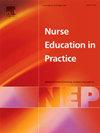Undergraduate nursing students’ personality and learning effectiveness in high-fidelity simulation education
IF 3.3
3区 医学
Q1 NURSING
引用次数: 0
Abstract
Aim
To examine the correlation between undergraduate nursing students’ personality and high-fidelity simulation learning effectiveness.
Background
Simulation is a fundamental approach in nursing education, with learning outcomes associated with various factors. Personality, reflecting on one’s way of learning, thinking and behaving, is a potential factor associated with simulation learning.
Design
A descriptive correlational study was conducted.
Methods
68 final year undergraduate nursing students completed an online survey following a high-fidelity nursing simulation. The five personality traits of neuroticism, extraversion, openness, conscientiousness and agreeableness were examined using the Neuroticism-Extraversion-Openness Five-Factor Inventory 3 (NEO-FFI-3). To investigate the relationship between personality and learning effectiveness, the revised English version of the Simulation Learning Effectiveness Inventory (SLEI) was also completed.
Results
No significant association was found between the five personality traits and students’ simulation learning effectiveness. However, the SLEI subscale of ‘resources’ was positively correlated with the trait of conscientiousness (r = 0.248, p = 0.04). In addition, students’ nursing work experience was associated with their learning effectiveness in high- fidelity simulation. Nursing students scored the highest in the personality trait of agreeableness (35.04 SD 5.28) and the lowest in that of neuroticism (26.53 SD 7.33).
Conclusions
Understanding personality assists in the application of best practice simulation for undergraduate nursing students. The design and implementation of high-fidelity simulation needs to consider students’ previous nursing work experience.
高保真模拟教育中本科护生的个性与学习效能
目的探讨本科护生人格特征与高保真模拟学习效果的相关性。模拟是护理教育的一种基本方法,其学习效果与多种因素有关。个性反映了一个人的学习、思考和行为方式,是与模拟学习相关的潜在因素。设计进行描述性相关研究。方法对68名大四护理专业学生进行高保真护理模拟后的在线调查。采用神经质-外向性-开放性五因素量表(NEO-FFI-3)对神经质、外向性、开放性、严谨性和宜人性五种人格特征进行测试。为了探讨人格与学习效能之间的关系,我们还完成了修订后的英文模拟学习效能量表(SLEI)。结果五种人格特质与学生模拟学习效能无显著相关。然而,“资源”的SLEI子量表与责任心特征正相关(r = 0.248,p = 0.04)。此外,学生的护理工作经验与高保真度模拟的学习效能有关。护生人格特质得分最高的是宜人性(35.04 SD 5.28),最低的是神经质(26.53 SD 7.33)。结论理解人格有助于最佳实践模拟在护理本科学生中的应用。高保真仿真的设计与实现需要考虑学生以往的护理工作经验。
本文章由计算机程序翻译,如有差异,请以英文原文为准。
求助全文
约1分钟内获得全文
求助全文
来源期刊

Nurse Education in Practice
NURSING-
CiteScore
5.40
自引率
9.40%
发文量
180
审稿时长
51 days
期刊介绍:
Nurse Education in Practice enables lecturers and practitioners to both share and disseminate evidence that demonstrates the actual practice of education as it is experienced in the realities of their respective work environments. It is supportive of new authors and will be at the forefront in publishing individual and collaborative papers that demonstrate the link between education and practice.
 求助内容:
求助内容: 应助结果提醒方式:
应助结果提醒方式:


